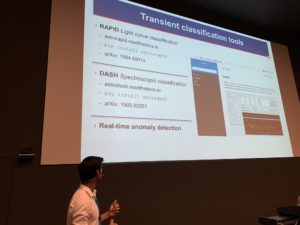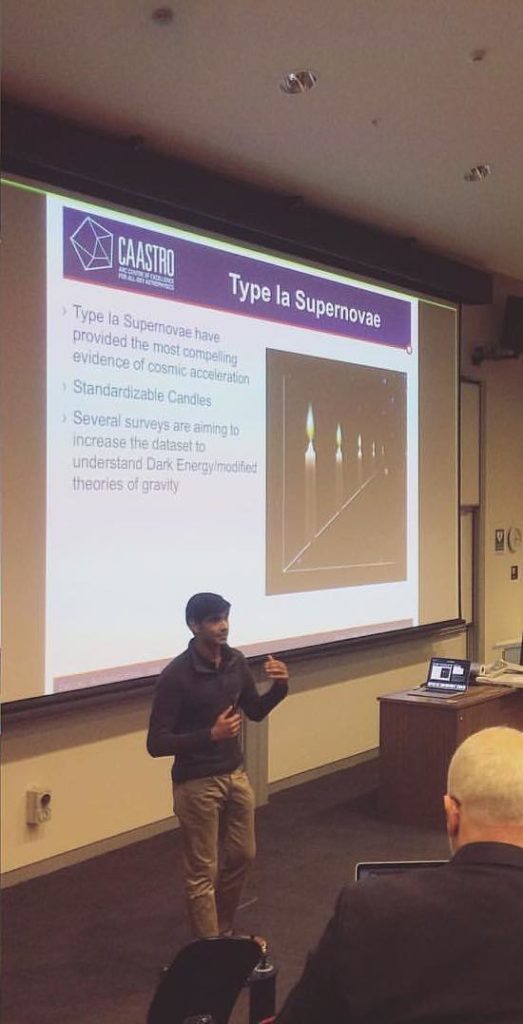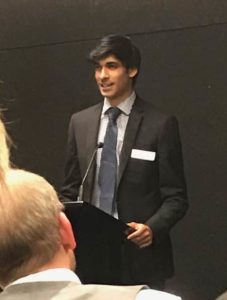Publications and Talks
* My students
Journal Articles
- Muthukrishna, D., Audenaert, J., Gregory, P., Hogg, D., Villar, A., Causal Foundation Models: Disentangling Physics from Instrument Properties. Accepted at the Foundation Models for Structured Data Workshop at the Forty‑Second International Conference on Machine Learning (ICML) 2025.
- Muthukrishna, D., Vanderspek, R., Conditional Diffusion models for Correcting Systematic Effects in Astronomical Images from Space Telescopes. in prep
- Gupta, R., Muthukrishna, D., Rehemtulla, N., Shah, V., Transfer Learning for Transient Classification: From Simulations to Real Data and ZTF to LSST. 2025, in review at MNRAS Letters. https://arxiv.org/abs/2311.17143
- Hon, M., et al. (incl Muthukrishna, D.), A Disintegrating Rocky Planet with Prominent Comet‑like Tails Around a Bright Star. 2025, accepted to AAS Journals. https://arxiv.org/abs/2501.05431
- *Gupta, R., Muthukrishna, D., Lochner, M., A Classifier-Based Approach to Multi-Class Anomaly Detection for Astronomical Time-Series. 2024, AI for Science, International Conference for Machine Learning (ICML) 2024. https://arxiv.org/abs/2408.08888
- *Gupta, R., Muthukrishna, D., Lochner, M., A Classifier‑Based Approach to Multi‑Class Anomaly Detection for Astronomical Transients, RAS Techniques & Instruments, 4, 2025, rzae054. https://arxiv.org/abs/2403.14742
- *Huang, H., Muthukrishna, D., *Nair, P., *Zhang, Z., Fausnaugh, M., *Majumder, T., Foley, R., Ricker, G. Predicting the Age of Astronomical Transients from Real‑Time Multivariate Time Series. 2023, Machine Learning and the Physical Sciences Workshop, Neural Information Processing Systems (NeurIPS) 2023. https://arxiv.org/abs/2311.17143
- Fausnaugh, M., et al. (incl Muthukrishna, D.), Four years of Type Ia Supernovae Observed by TESS. 2022, ApJ, 956, 108. https://arxiv.org/abs/2307.11815
- Agarwal, M., et al. (incl Muthukrishna, D.) Applications of Deep Learning to physics workflows. 2023. https://arxiv.org/abs/2306.08106
- Tey, E., et al. (incl Muthukrishna, D.), Identifying Exoplanets with Deep Learning. V. Improved Light Curve Classification for TESS Full Frame Image Observations. 2022, AJ, 165, 95. https://arxiv.org/abs/2301.01371
- Biswas, E., Ishida, E., et al. (incl Muthukrishna, D.), Enabling the discovery of fast transients: A science module for the Fink broker. 2022, A&A, 677, A77. https://arxiv.org/abs/2210.17433

- D. Muthukrishna, K. Mandel, M. Lochner, S. Webb, G. Narayan, Real-time detection of anomalies in large-scale transient surveys, MNRAS. (2021). https://arxiv.org/abs/2111.00036
- D. Muthukrishna, K. Mandel, M. Lochner, S. Webb, G. Narayan, Real-time Detection of Anomalies in Multivariate Time Series of Astronomical Data, Neurips workshop on Machine Learning and the Physical Sciences. (2021). https://arxiv.org/abs/2112.08415
- D. Chatterjee, G. Narayan, P. Aleo, K. Malanchev, D. Muthukrishna, Electromagnetic Counterpart Identification of Gravitational-wave candidates using deep-learning, Neurips workshop on Machine Learning and the Physical Sciences. (2021). Link to paper
- D. Chatterjee, G. Narayan, P. Aleo, K. Malanchev, D. Muthukrishna, El-CID: A filter for Gravitational-wave Electromagnetic Counterpart Identification, MNRAS. (2021). https://arxiv.org/abs/2108.04166
- R. Hložek, et al., Results of the Photometric LSST Astronomical Time-series Classification Challenge (PLAsTiCC). (2021). https://arxiv.org/abs/2012.12392
- D. O. Jones, et al., The Young Supernova Experiment: Survey Goals, Overview, and Operations, ApJ. (2020). https://arxiv.org/abs/2010.09724
- S. Webb, M. Lochner, D. Muthukrishna, et al., Unsupervised machine learning for transient discovery in Deeper, Wider, Faster light curves, MNRAS. (2020). https://arxiv.org/abs/2008.04666
- C. Stachie et al., Using machine learning for transient classification in searchers for gravitational-wave counterparts, MNRAS. (2020). https://arxiv.org/abs/1912.06383
- D. Muthukrishna, G. Narayan, K. Mandel, R. Biswas, R. Hložek, RAPID: Early classification of explosive transients using Recurrent Neural Networks, PASP. (2019). https://arxiv.org/abs/1904.00014
- D. Muthukrishna, D. Parkinson and B. Tucker, DASH: Deep Learning for the Automated Spectral Classification of Supernovae and their Hosts, ApJ (2019). https://arxiv.org/abs/1903.02557
- R. S. de Jong, et al., 4MOST: Project overview and information for the First Call for Proposals, The Messenger (2019). https://doi.eso.org/10.18727/0722-6691/5117
- R. Kessler et al., Models and Simulations for the Photometric LSST Astronomical Time Series Classification Challenge (PLAsTiCC), PASP. (2019). https://arxiv.org/abs/1903.11756
- DES Collaboration et al., First Cosmology Results using Type Ia Supernovae from the Dark Energy Survey: Constraints on Cosmological Parameters, ApJ. (2018). https://arxiv.org/abs/1811.02374.
- D. Brout, et al., First Cosmology Results Using Type Ia Supernovae From the Dark Energy Survey: Analysis, Systematic Uncertainties, and Validation, ApJ. (2018). https://arxiv.org/abs/1811.02377.
- R. Kessler, et al., First Cosmology Results using Type Ia Supernova from the Dark Energy Survey: Simulations to Correct Supernova Distance Biases, ApJ. (2018). https://arxiv.org/abs/1811.02379.
- C. Andrea, et al., First Cosmology Results Using Type Ia Supernovae From the Dark Energy Survey: Survey Overview and Supernova Spectroscopy, ApJ. (2018). https://arxiv.org/abs/1811.09565.
- A. Malz, et al., The Photometric LSST Astronomical Time-series Classification Challenge (PLAsTiCC): Selection of a performance metric for classification probabilities balancing diverse science goals, ApJ (submitted), https://arxiv.org/abs/1809.11145.
- F. Campuzano, G. Bosch, G. Hägele, V.Firpo, D. Muthukrishna, M. Cardaci, Chemodynamics in Blue Compact Dwarf galaxies: II Zw 33 and Mrk 600, Boletín de la Asociación Argentina de Astronomía, 60, p.148-150 (2018). http://adsabs.harvard.edu/abs/2018BAAA…60..148C.
- M. J. Childress, et al., OzDES multi-object spectroscopy for the Dark Energy Survey: 3-yr results and first data release, MNRAS. 472 (2017). https://doi.org/10.1093/mnras/stx1872.
- D. Muthukrishna and D. Parkinson, A cosmographic analysis of the transition to acceleration using SN-Ia and BAO, J. Cosmol. Astropart. Phys. (2016). http://iopscience.iop.org/article/10.1088/1475-7516/2016/11/052.
- V. Firpo, D. Muthukrishna, F. Campuzano-Castro, S. Torres-Flores, G. Bosch and G. Hagele, Violent star-forming processes in interacting galaxies, MNRAS. (2018). (in preparation).
White Papers and Notes
- G. Allen, et al., Multi-Messenger Astrophysics: Harnessing the Data Revolution [White Paper], ArXiv e-prints (2018). http://adsabs.harvard.edu/abs/2018arXiv180704780A.
- The PLAsTiCC Team, et al., The Photometric LSST Astronomical Time-series Classification Challenge (PLAsTiCC): Data set (2018). http://adsabs.harvard.edu/abs/2018arXiv181000001T.
Astronomical Telegrams
- E. Shaya, et al. TNS Astronomical Transient Report No. 20724, (2018). https://wis-tns.weizmann.ac.il/object/2018dzv/discovery-cert.
- L. Davies, et al., Classification of 3 DES supernova with OzDES and DEVILS, The Astronomer’s Telegram 11717 (2018). http://adsabs.harvard.edu/abs/2018ATel11717….1D.
- E. Swann, et al., Classification of 18 DES supernova with OzDES The Astronomer’s Telegram 11679 (2018). http://adsabs.harvard.edu/abs/2018ATel11679….1S.
- C. Angus, et al., Classification of 2 DES supernova by NTT, The Astronomer’s Telegram 11151 (2018). http://adsabs.harvard.edu/abs/2018ATel11151….1A.
- L. Galbany, et al., Classification of 5 DES supernova by Magellan, The Astronomer’s Telegram 11150 (2018). http://adsabs.harvard.edu/abs/2018ATel11150….1G.
- E. Macaulay, et al., Classification of 13 DES supernova with OzDES, The Astronomer’s Telegram 11148 (2018). http://adsabs.harvard.edu/abs/2018ATel11148….1M.
- J. Calcino, et al., Classification of 26 DES supernova with OzDES, The Astronomer’s Telegram 11147 (2018). http://adsabs.harvard.edu/abs/2018ATel11147….1C.
- J. Calcino, et al., Classification of 25 DES supernova with OzDES, The Astronomer’s Telegram 11146 (2018). http://adsabs.harvard.edu/abs/2018ATel11146….1C.
- D. Muthukrishna, et al., Classification of 17 DES supernova with OzDES, The Astronomer’s Telegram 10759 (2017). http://adsabs.harvard.edu/abs/2017ATel10759….1M.
- L. Galbany, et al., Classification of 10 DES supernova by Magellan, The Astronomer’s Telegram 10913 (2017). http://adsabs.harvard.edu/abs/2017ATel10913….1G.
- B. E. Tucker, et al., WiFeS Classification of SMT17kdl/SN2017edm as a Type Ia Supernova, The Astronomer’s Telegram 10444 (2017). http://www.astronomerstelegram.org/?read=10444.
- B. E. Tucker, et al., First Confirmed Supernova with the SkyMapper/Zooniverse Supernova Sighting Project, The Astronomer’s Telegram 10426 (2017). http://adsabs.harvard.edu/abs/2017ATel10426….1T.
- R. Sharp, et al., Classification of 11 DES supernova with OzDES, The Astronomer’s Telegram 9961 (2017). http://adsabs.harvard.edu/abs/2017ATel.9961….1S.
- M. Sullivan, et al., Classification of DES16C3dmp as a SLSN-I by VLT, The Astronomer’s Telegram 9953 (2017). http://adsabs.harvard.edu/abs/2017ATel.9953….1S.
- J. K. Hoormann, et al., Classification of 17 DES Supernova with OzDES, The Astronomer’s Telegram 9855 (2016). http://adsabs.harvard.edu/abs/2016ATel.9855….1H.
- D. Mudd, et al., Classification of 17 DES supernova with OzDES, The Astronomer’s Telegram 9742 (2016). http://adsabs.harvard.edu/abs/2016ATel.9742….1M.
Invited Talks & Conference Presentations

- Korea Astronomy and Space Science Institute, Invited speaker at the Early Career Researcher Cosmology Seminar Series, (March 2022).
- Rubin Observatory’s Dark Energy Science Collaboration, Invited speaker at the Machine Learning Topical Team Seminar Series, (June 2021).
- Telstra (top Australian Telecommunications company), Invited speaker at the AI ML Forum, (March 2021).
- University of Sheffield, UK, Invited speaker at the Astronomy Seminar (December 2020).
- SLAC National Accelerator Laboratory at Stanford University, Guest speaker at the AI Seminar Series (February 2020).
- MIT, Cambridge, MA, USA, Guest speaker at the MIT Kavli Institute’s Brown Bach Lunch Talk Series (February 2020).
- University of Berkeley, San Francisco, California, USA, Guest speaker at the weekly SETI (Search of Extraterrestrial Intelligence) Meeting (February 2020).
- Texas A&M University, College Station, Texas USA, Invited speaker at the Astronomical Data Science Workshop (February 2020).
- DESY Zeuthen, Germany, Invited Astroparticle seminar speaker (November 2019).
- ESO Garching, Germany, Contributed talk to the ESO conference on The extragalactic explosive Universe: the new era of transient surveys and data-driven discovery, (September 2019), “Classifying transients and detecting anomalies in upcoming large-scale surveys”, Garching near Munich, Germany.
- Northwestern University, Illinois, USA, Invited speaker at the Hotwiring the transient universe workshop, (August 2019), “RAPID: Early Classification of Explosive Transients using Deep Learning”, Evanston, Illinois, USA.
- Joint Statistical Meeting (JSM), Colorado, USA, Invited to the conference for being nominated for the Best Student Paper in Astrostatistics Award, (July 2019), “Time-series classification with Recurrent Neural Networks”, Denver, Colorado.
- EWASS, Lyon, France, Contributed talk to the Time-domain symposium at the annual European Week of Astronomy and Space Science, (June 2019), “Early classification of transients”, Lyon, France.
- Institute of Astronomy, University of Cambridge, Wednesday seminar, (June 2019), “Real-Time Classification of Explosive Transients Using Deep “, Cambridge, UK.
- Space Telescope Science Institute, Baltimore, USA, Contributed talk at the Enabling Multi-messenger Astrophysics in the Big Data Era, (April 2019), “RAPID: Early Classification of Explosive Transients using Deep Learning”, Baltimore, USA.
- Royal Astronomical Society, London, UK, Contributed talk at the Machine learning and Artificial Intelligence applied to astronomy workshop (March 2019), “RAPID: Real-time classification of explosive transients using Deep learning”, London, UK.
- University of California, Santa Cruz, Transient Talk (March 2019), “RAPID: Real-time classification of explosive transients using Deep learning”, UC Santa Cruz, USA.
- Harvard University (January 2019), “Real-time classification of explosive transients using deep recurrent neural networks”, Talk to CHASC Topics in Astrostatistics group.
- Clare College, Cambridge, Invited talk to non-scientific audience (October 2018), “What is “Dark Energy, and how can exploding stars and machine learning help us find out if Einstein was right?”, Cambridge, United Kingdom.
- University of Oxford, Contributed talk at the Wetton Workshop: Planning for Surprises in the era of Data-Driven Astronomy (June 2018), “Transient Classification with machine learning”, Oxford, United Kingdom.
- CAASTRO Local Area Meeting (July 2017), “DASH: Deep learning for supernova classification in OzDES“, Sydney, Australia.
- Astronomical Society of Australia Annual Meeting, Contributed talk at ANU (July 2017), “DASH: Deep learning for supernova classification“, Canberra, Australia.
- University of Chicago, Contributed talk at the DES Collaboration Meeting, (June 2017), “Spectral classification of the Type-Ia supernova sample“, University of Chicago, USA.
- Machine Learning in Astronomy Meetings, Invited talk (April 2017), “DASH: Deep Learning or the Spectral Classification of Supernovae“.
- Gemini Observatory, Chile (Feb 2017), “Modelling emission line profiles in Giant HII Regions“. La Serena, Chile.
- OzDES Science Workshop (Feb 2017), “DASH Tutorial to OzDES classifiers“, Canberra, Australia.
- University of Chile, Invited talk to ML and transient group (Jan 2017), “DASH: Deep Learning for the Spectral Classification of Supernovae“, Santiago, Chile.
- Australian National University, Feast of Facts talk (Oct 2016), “Model-independent Cosmology“, Canberra, Australia.
Conference Posters
-

Daniel Muthukrishna, Kaisey Mandel, Michelle Lochner, Sara Webb, Gautham Narayan, Early Classification of Explosive Transients, Poster presented at the 35th Conference on Neural Information Processing Systems (NeurIPS), USA (Dec 2021).
- Daniel Muthukrishna, Gautham Narayan, Kaisey Mandel, Rahul Biswas and Renee Hlozek, Real-time Detection of Anomalies in Multivariate Time Series of Astronomical Data, Poster presented at the 233rd American Astronomical Society Meeting in Seattle, USA (Jan 2019). http://adsabs.harvard.edu/abs/2019AAS…23325824N
- D. Muthukrishna, K. Mandel, and G. Narayan, Deep Learning for Real-Time Classification of Transient Time Series from Massive Astronomical Data Streams, Poster presented at the Cantab Capital Institute for the Mathematics of Information – connecting with industry workshop in Cambridge, UK (Nov 2018).
- N. Lowson, D. Muthukrishna, B. Tucker, Determining the progenitor of the peculiar transient DES16X3bdj, Poster presented at the Astronomical Society of Australia Annual Meeting in Canberra, Australia (Jul 2017).
- V. Firpo, D. Muthukrishna, F. Campuzano-Castro, S. Torres-Flores, G. Bosch and G. Hägele, Violent star-forming processes in interacting galaxies, Poster presented at the European Week of Astronomy and Space Science (EWASS) in Prague, Czech Republic (Jun 2017).
- D. Muthukrishna, D. Parkinson and B. Tucker, DASH: Deep Learning for the Spectral Classification of Supernovae, Poster presented at the 6th Annual CAASTRO Conference in Perth, Australia (Nov 2016). http://danielmuthukrishna.com/wp-content/uploads/2016/12/CAASTROConferencePoster_v3.pdf
Theses
- Data-driven Discovery of Transients in the New Era of Time-Domain Astronomy (Doctoral thesis). https://doi.org/10.17863/CAM.77709
- D. Muthukrishna, Deep Learning for the Spectral Classification of Supernovae, Unpublished Honours Thesis, University of Queensland, Brisbane, Australia, (2016). http://danielmuthukrishna.com/projects/dash-thesis/